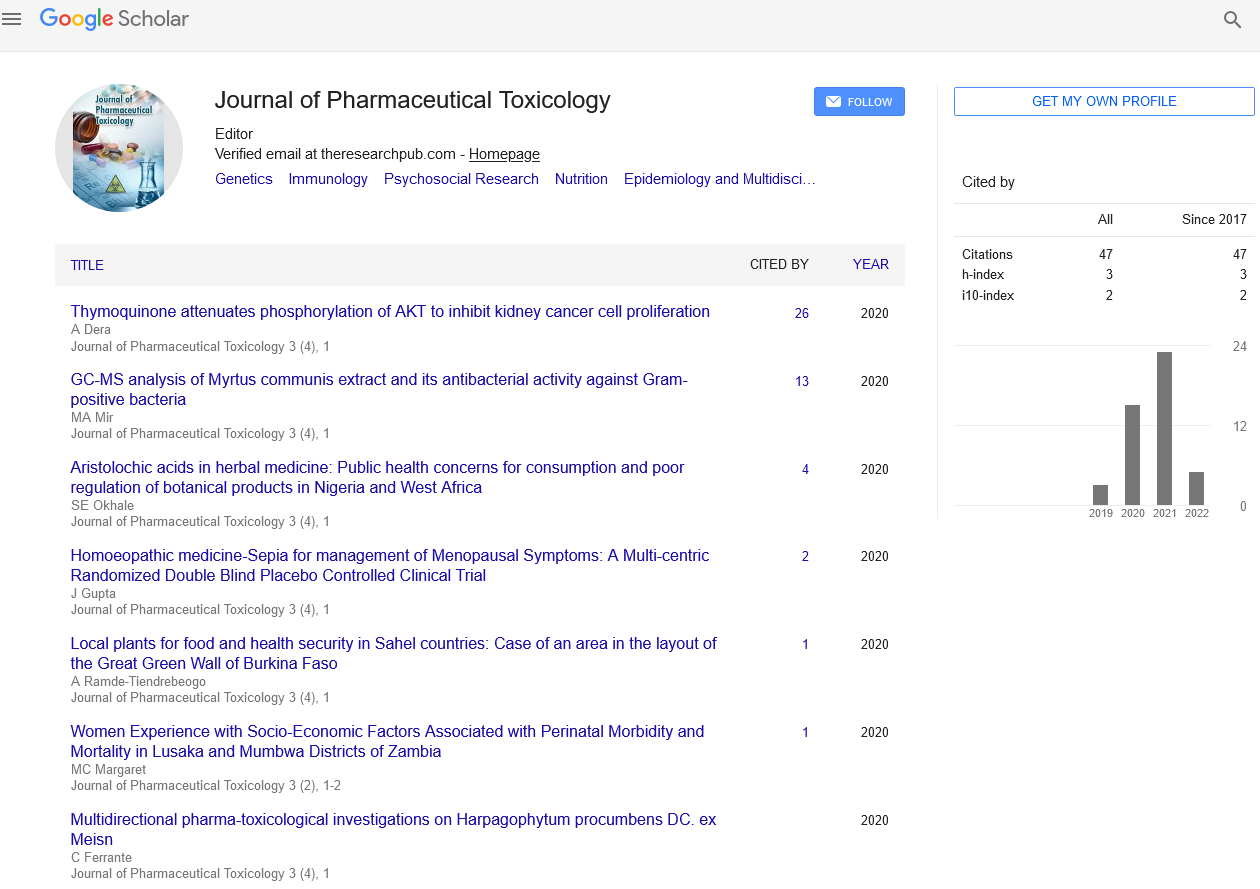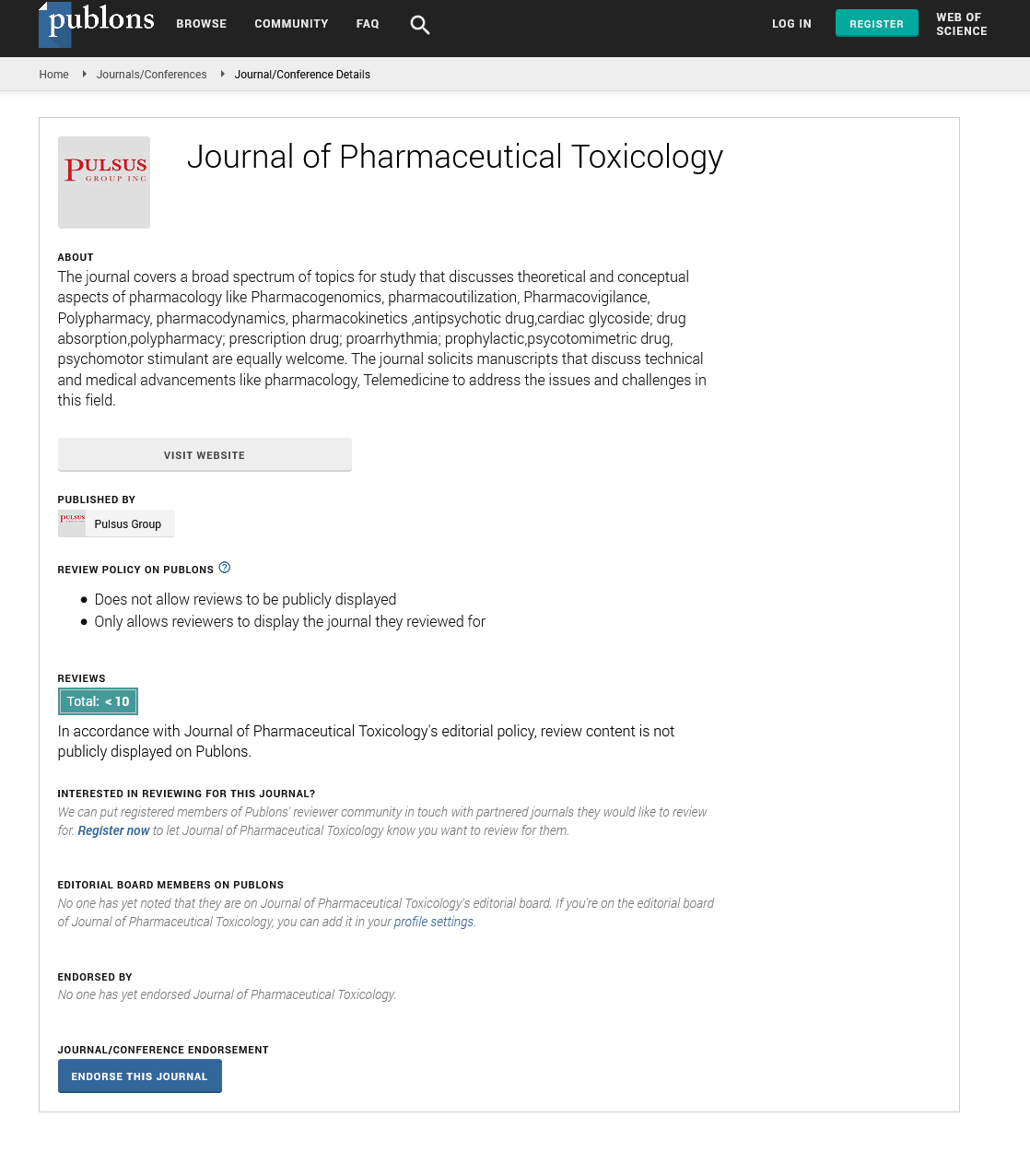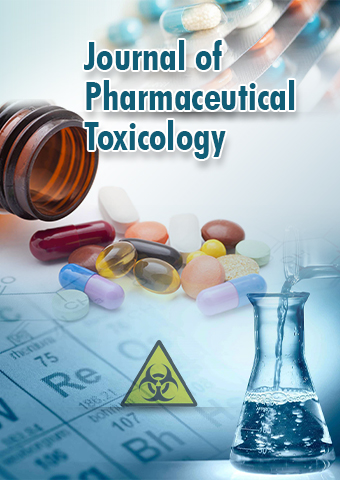Review Article - Journal of Pharmaceutical Toxicology (2023) Volume 6, Issue 1
A Review of the In Vivo and In Vitro Studies on Recent Advances in Particulate Matter and Nanoparticle Toxicology
Riyaz Ali*
Department of Pharmaceutical Sciences, School of Applied Science and Technology, University of Kashmir, Srinagar 190006, India
Department of Pharmaceutical Sciences, School of Applied Science and Technology, University of Kashmir, Srinagar 190006, India
E-mail: riyazali2023@gmail.com
Received: 01-Feb-2023, Manuscript No. jpt-23-89049; Editor assigned: 04-Feb-2023, PreQC No. jpt-23- 89049(PQ); Reviewed: 18-Feb-2023, QC No. jpt-23-89049; Revised: 25-Feb-2023, Manuscript No. jpt-23- 89049(R); Published: 28-Feb-2023, DOI: 10.37532/jpt.2023.6(1).13-16
Abstract
Particulate matter (PM) exposure has been linked to negative health effects in epidemiological and clinical studies, including an increase in cardiopulmonary disease mortality and morbidity. Even though there is evidence that PM has negative effects on health, the physiological, cellular, and molecular mechanisms that cause these effects are still poorly understood. To explain how toxicity works, there are two main approaches. One is the utilization of in vivo experimental models, which permit evaluation of various PM effects on and nervous systems. The use of various in vitro models has proven useful for examining the molecular and cellular mechanisms underlying the various physiological effects in greater depth. On the basis of these methods, we discuss the most recent advancements in the toxicology of nanoparticles and particulate matter.
Keywords
antioxidant activity • health effects • cerium oxide nanoparticles • toxicity • epidemiology studies • particle toxicology
Introduction
Mortality and emergency room visits are both increased when people are exposed to particulate matter (PM). The 1930 fog in the Meuse Valley, the 1948 smog in Donora, and the 1952 great smog in London all sparked research into the health effects of PM exposure in large cities and, later, PM level limit legislation. The Clean Air Act, for instance, was enacted in the United States in 1972. Particles inhaled enter the respiratory system and target various anatomical locations based, among other properties, on their aerodynamic size. Aerodynamic size, PM10 (thoracic particles smaller than 10 m) and PM2.5 (fine particles smaller than 2.5 m) are the two categories of particles. The term “coarse fraction” refers to particles with aerodynamic sizes between 10 and 2.5 micrometres. Ultrafine particles (UFP) are particles with an aerodynamic size of less than 0.1 m. Diesel exhaust (DEP) is one of the main sources of this kind of primary particles. Nanoparticles (NP) are engineered particles that are measured by their geometric size and have at least one dimension smaller than 0.1 m. The primary anatomical target of particles of various sizes is summarized in Air Quality Standards, which have been adopted by numerous nations to guard against the harmful effects of air pollution on public health and welfare [1]. In point of fact, guidelines for air pollutants have been adopted by WHO member nations in their constitutions. PM10 concentrations should not exceed 50 g/m3 per day, according to the WHO, which has representatives from nearly 200 nations. However, many nations have decided to establish Air Quality Standards that are either less strict or more stringent than the WHO Standard. National policy and scientific evidence that suggests a connection between pollution exposure and health problems are typically the basis for the development or revision of air quality standards [2].
Even though efforts have been made to measure the health effects of inhaled particulate matter, we still do not fully understand all of the effects and mechanisms that are related to those effects. We also do not fully understand the role that the length (size), shape, and composition of particles play in their biological effects. In this paper, we reviewed the relevant information that is related to three main aspects of the problem: 1) the determination and function of particles’ chemical and biological components; 2) the evaluation of their in vivo effects at pulmonary and systemic targets; and 3) the mechanisms by which particles of various sizes, shapes, and composition affect cells. We select those articles from among the many that have been published in these fields that, in our opinion, aid in comprehending the various issues and pose new questions, pushing the boundaries of our knowledge [3].
Materials and Methods
Trypsin, RPMI 1640 and M199 media, and HyClone fetal bovine serum (FBS) were purchased from GIBCO/BRL (Grand Island, NY, USA). NUNC and COSTAR supplied the sterile plastic that was used for tissue culture. Becton Dickinson, Immunocytometry Systems (San José, CA, USA) supplied the flow cytometry reagents. R & D Systems (Minneapolis, MN, USA) supplied TNF-. Santa Cruz Biotechnology (Santa Cruz, CA, USA) supplied the monoclonal antibody against Von Willebrand factor that was labelled with peroxidase. TiO2 NPs and H2DCFDA were obtained from Paris Drugstore (Mexico City, Mexico) and Molecular Probes, respectively. Sigma Aldrich (St. Louis, MO, USA) supplied all other chemicals [4].
The night before each experiment, at least 1 mg of particles were weighed and sterilized by autoclave. A few minutes prior to the exposure of the cells, suspensions containing PM10 and TiO2 NPs at a concentration of 1 mg/mL were prepared in M199 medium. To achieve the required final concentration, aliquots from these suspensions were further diluted with culture medium. Our group has previously characterized the TiO2 NPs used. When TiO2 NPs were suspended in M199 medium with 10% FBS, their characterization revealed aggregates of spheres with a diameter of less than 50 nm, a size distribution. Since there was no difference in the biological effects of sonicated and nonsonicated TiO2 NPs in our previous research, we did not sonicate the NPs in our assays [5].
Discussion
Particulate matter (PM) comes from both natural and man-made sources, and humans have been exposed to it for thousands of years. Health issues associated with miners’ dust exposure have been documented since the first third of the twentieth century. Inhaling particulates has been linked to a number of lung diseases, including lung fibrosis and lung cancer, according to early epidemiological data. The 1930 fog in the Meuse Valley, the 1948 smog in Donora, and the 1952 smog in London laid the groundwork for legislation regarding air pollutants [6]. The Clean Air Act was enacted in the United States in 1972. Prior to 1970, the primary focus of research in this area was on measuring PM suspended in the air and determining how it related to increases in lung disease-related mortality. Measurements of environmental particles improved in the 1970s and 1980s, and efforts to quantify particles of various aerodynamic sizes shed light on their potential connection to various diseases. These methods helped to identify the sources of various particles, which led to specific measures to limit PM emissions [7]. In the 1990s and the first decade of this century, a lot of research was done to figure out the cellular and molecular mechanisms of particle toxicity. Many studies have shown that the size and composition of the particles play a major role in the effects on the body. Concerns about the use of nanoparticles (NPs) and their potential effects on workers and end users have grown significantly over the past two decades. Presently, it is evident that particles inhaled may have local and systemic effects, and that the toxicity of these airborne particles is largely determined by their size, composition, and physicochemical properties [8].
The figures mentioned earlier demonstrated the significance of a special issue on nanoparticle and particulate matter toxicology. Particle sampling and characterization, in vitro toxic affects characterization using conventional and novel models, PM effects in vivo, and NP effects in vivo and in vitro are some of the topics covered in this special issue.
We also include three reviews, one of which discusses the evidence linking inhalation of diesel particles and the increased risk of Alzheimer’s and Parkinson’s diseases to exposure to diesel particles [9]. The guest editors prepared a review of the current state of the art in in vivo and in vitro toxicological characterization of particles for this issue. In it, we discuss the most recent evidence of inhaled particle-induced local and systemic effects. Over the past 50 years, a lot of work has been done to learn about the toxicology of particles, and there is a lot of information out there about the dangers of being exposed to different kinds of particles. However, there is still a lot that needs to be done in the field, and the efforts that have been presented here will be very useful in expanding our understanding of the particulate matter toxicology field [10].
Conclusion
A highly complex mixture of gaseous and particulate agents makes up urban air pollution. While gaseous pollutants like ozone and SO2 play a significant role, the unifying factor in the negative health effects of urban air pollution is reparable PM, according to the majority of published studies. To better understand how PM affects various organs and diseases, numerous studies using animal models have been conducted. In terms of acute effects, the majority of studies have focused on inflammatory responses, and relatively few studies have included more disease-specific responses, possibly with the exception of allergy-related studies. On the other hand, more studies have elucidated disease-related processes, such as DNA damage, destruction of lung parenchyma, increased plaque volume in arteries, lung fibrosis, or granuloma formation, in relation to chronic effects. The in vivo models’ usefulness would be enhanced if they placed a greater emphasis on more direct diseaserelated parameters in models that closely resemble human disease patterns.
It would be interesting for the interpretation of results if the in vivo studies could also to a greater extent cover mechanistic effects, in order to discover a possible coherence of results with the in vitro studies. This is because the in vitro models prove to be the most useful for studying mechanistic responses, such as the initiation events of inflammatory effects or Genotoxicity. In light of the fact that some in vitro endpoints, particularly Genotoxicity, have been linked to indicators of cancer development and disease; this relationship has not fully matured in relation to other end points. It is necessary to further develop improved in vitro models that aim to cover this field.
The in vitro models have been helpful in determining the significance of various components and particle sizes. Due to their increased reactivity, surface area, and massbased particle number, for instance, evidence suggests that the ultrafine fraction of these particles exhibits greater toxicity at equal mass concentrations than the larger fraction. In addition, it has been demonstrated that certain in vitro cellular effects and responses coexist in biopsies taken from human volunteers who were exposed to diesel exhaust particles. However, the use of sometimes extremely high concentrations in in vitro models calls for the creation of more sensitive models and caution when interpreting in vitro results. Products made with nanotechnology have very different chemical and physical properties. They are also used in diagnostics, imaging, drug delivery, information and communication technologies, and consumer and industrial products are just beginning to use them extensively. Therefore, structure activity and in vitro studies will be of assistance in coping with such a variety of material types and applications.
Conflict of Interest
None
Acknowledgement
None
References
- Heppleston G. Pulmonary toxicology of silica, coal and asbestos. Environ Health Perspect. 55:111-127 (1984).
- Monn C, Becker S. Cytotoxicity and induction of proinflammatory cytokines from human monocytes exposed to fine (PM2.5) and coarse particles (PM10-2.5) in outdoor and indoor air. Toxicol Appl Pharmacol. 155:245-252 (1999).
- Steerenberg PA, Van Amelsvoort L, Lovik M et al. Relation between sources of particulate air pollution and biological effect parameters in samples from four European cities: an exploratory study. Inhal Toxicol. 18:333-346 (2006).
- Soukup JM, Becker S. Human alveolar macrophage responses to air pollution particulates is associated with insoluble components of coarse material, including particulate endotoxin. Toxicol Appl Pharmacol. 171:20-26 (2001).
- Wilson MR, Lightbody JH, Donaldson K et al. Interactions between ultrafine particles and transition metals in vivo and in vitro. Toxicol Appl Pharmacol. 184172-179 (2002).
- Thorne PS. Inhalation toxicology models of endotoxin-and bio aerosol-induced inflammation. Toxicology. 152:13-23 (2000).
- Nemmar A, Al-Salam S, Zia S et al. Contrasting actions of diesel exhausts particles on the pulmonary and cardiovascular systems and the effects of thymoquinone. Br J Pharmacol. 164:1871-1882 (2011).
- Riva DR, Magalhães CB, Lopes AA et al. Low dose of fine particulate matter (PM2.5) can induce acute oxidative stress, inflammation and pulmonary impairment in healthy mice. Inhal Toxicol. 23:257-267 (2011).
- Paraskevas KI, Tzovaras AA, Briana DD et al. emerging indications for statins: a pluripotent family of agents with several potential applications. Curr Pharm Des. 13:3622-3636 (2007).
- Kim JS, Adamcakova-Dodd A, Grassian VH et al. Effects of copper nanoparticle exposure on host defense in a murine pulmonary infection model. Part Fibre Toxicol. 8:269 (2011).
Google Scholar, Crossref, Indexed at
Google Scholar, Crossref, Indexed at
Google Scholar, Crossref, Indexed at
Google Scholar, Crossref, Indexed at
Google Scholar, Crossref, Indexed at
Google Scholar, Crossref, Indexed at
Google Scholar, Crossref, Indexed at
Google Scholar, Crossref, Indexed at
Google Scholar, Crossref, Indexed at


